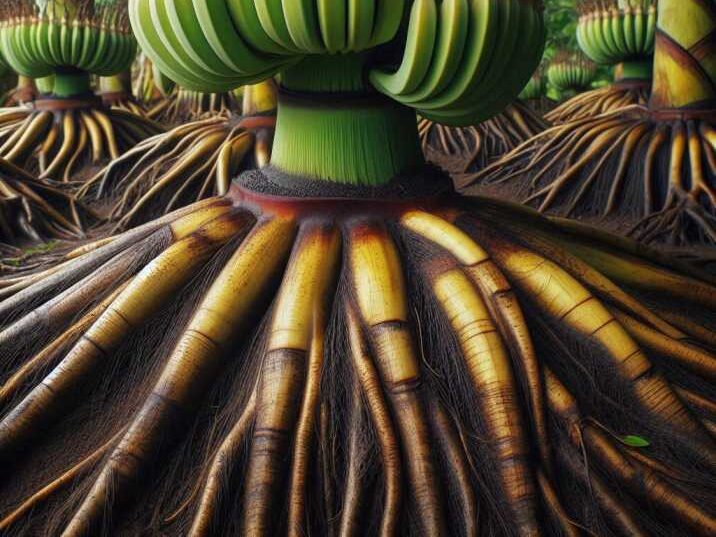Introduction
Table of Contents
Selecting the healthiest baby banana plants is essential for a thriving and productive banana plantation. Bananas are a favourite fruit in many households, and growing them can be a rewarding experience. This article will guide you through the steps to identify and select the best baby banana plants for cultivation, ensuring you have a fruitful harvest. We’ll cover the importance of healthy baby banana plants, the characteristics to look for, and the best practices for selecting them.

Importance of Healthy Banana Plants
Healthy banana plants are crucial for a successful harvest. They are more resistant to diseases, pests, and environmental stresses. Selecting robust plants at the beginning of your cultivation journey can save you time, money, and effort in the long run.
Characteristics of Healthy Baby Banana Plants
1. Vibrant Green Leaves
Healthy banana plants have bright green leaves, which are a clear indicator of their good health. The absence of yellowing or browning on the leaves signifies that the plant is receiving adequate nutrients and is free from stress factors such as pests or diseases. Firm and upright leaves also suggest that the plant is well-hydrated and robust. When selecting baby banana plants, always look for those with vibrant green leaves, as this is a key sign of a healthy and thriving plant.
2. Strong and Thick Pseudostem
The pseudostem, which appears similar to a trunk but is a collection of tightly packed leaf bases, plays a crucial role in supporting the banana plant. A thick and sturdy pseudostem indicates a strong plant that has the potential to support the heavy weight of banana bunches as they grow. A robust pseudostem also suggests that the plant has a well-developed root system and is absorbing nutrients effectively. When choosing baby banana plants, opt for those with thick and sturdy pseudostems to ensure they can withstand the demands of fruit production.
3. Healthy Root System
Inspecting the roots of baby banana plants is essential to determine their overall health. Healthy roots are white and fibrous, indicating they are actively growing and capable of efficiently absorbing water and nutrients from the soil. Avoid plants with brown or mushy roots, as these are signs of root rot or other diseases. A healthy root system is fundamental for the plant’s growth and development, so make sure to check the roots before selecting your baby banana plants.
4. No Signs of Pests or Diseases
It is important to thoroughly inspect the plant for any signs of pests or diseases before making your selection. Look for holes in the leaves, which could indicate pest damage, and check for webbing that might be a sign of spider mites. Additionally, examine the leaves for any spots, streaks, or unusual discolourations that could suggest the presence of diseases. Choosing plants that are free from pests and diseases will help ensure that your banana plantation remains healthy and productive.
Explanation of Key Characteristics
Vibrant Green Leaves
- What to Look For: Bright green colour, no yellowing or browning, firm and upright leaves.
- Why It Matters: Indicates adequate nutrition, hydration, and overall plant health. It shows the plant is free from stress factors and can photosynthesize effectively.
Strong and Thick Pseudostem
- What to Look For: Thickness and sturdiness of the pseudostem.
- Why It Matters: A strong pseudostem is crucial for supporting the plant’s weight as it grows. It reflects a well-developed root system and efficient nutrient absorption.
Healthy Root System
- What to Look For: White and fibrous roots, no brown or mushy roots.
- Why It Matters: Healthy roots are essential for water and nutrient uptake, critical for the plant’s growth and resilience.
No Signs of Pests or Diseases
- What to Look For: Absence of holes, webbing, spots, streaks, or unusual discolourations on the leaves.
- Why It Matters: Ensuring the plant is free from pests and diseases at the start prevents future problems and promotes a healthy, productive plantation.
Best Practices for Selecting Baby Banana Plants
1. Choose Certified Disease-Free Plants
- Purchasing plants from reputable nurseries that offer certified disease-free banana plants can help ensure you start with healthy plants.
2. Inspect Before Buying
- Always inspect the plants in person if possible. Look for the qualities listed above to ensure you are selecting the healthiest plants.
3. Ask for Expert Advice
- If you are new to banana cultivation, seek advice from experienced growers or agricultural extension services. They can provide valuable insights and recommendations.
Step-by-Step Guide to Selecting the Healthiest Baby Banana Plants
Visit a Reputable Nursery
- Start by visiting a nursery known for its healthy and disease-free plants. Ask about the source of their plants and their disease management practices.
Inspect the Leaves
- Look for vibrant green leaves with no yellowing or spots. Ensure the leaves are firm and upright.
Check the Pseudostem
- Examine the pseudostem to ensure it is thick and sturdy. Avoid plants with thin or weak pseudostems.
Examine the Roots
- If possible, gently remove the plant from its container to inspect the roots. Look for white, fibrous roots and avoid plants with brown or mushy roots.
Look for Pest and Disease Signs
- Inspect the entire plant for any signs of pests or diseases. Avoid plants with holes in the leaves, webbing, spots, or streaks.
Additional Tips for Successful Banana Cultivation
1. Proper Spacing
- Ensure proper spacing between banana plants to allow for adequate air circulation and prevent the spread of diseases.
2. Adequate Watering
- Bananas require consistent watering, but avoid overwatering as it can lead to root rot. Keep the soil moist but not waterlogged.
3. Fertilization
- Use a balanced fertilizer to provide the necessary nutrients for healthy growth. Follow the recommended application rates to avoid over-fertilization.
4. Pest and Disease Management
- Regularly monitor your banana plants for signs of pests and diseases. Implement integrated pest management practices to keep your plants healthy.
5. Mulching
- Mulching around the base of your banana plants can help retain moisture, suppress weeds, and provide organic matter to the soil.

Table of Information
| Characteristic | Ideal Condition |
|---|---|
| Leaf Color | Bright green with no yellowing or spots |
| Pseudostem Thickness | Thick and sturdy |
| Root Condition | White and fibrous |
| Pest Signs | None |
| Disease Signs | None |
Conclusion
Selecting the healthiest baby banana plants for cultivation is a crucial step in ensuring a successful banana harvest. By paying attention to key characteristics such as leaf colour, pseudostem thickness, root health, and signs of pests or diseases, you can make informed decisions and start your banana plantation on the right foot. Remember to follow best practices for banana cultivation, including proper spacing, adequate watering, and regular monitoring for pests and diseases. With these tips, you’ll be well on your way to growing robust and productive banana plants.
FAQs
- What are the signs of a healthy baby banana plant?
- Bright green leaves, a thick pseudostem, healthy white roots, and no signs of pests or diseases.
- Why is it important to select disease-free banana plants?
- Disease-free plants are more likely to thrive and produce a healthy harvest, saving you time and resources in the long run.
- Can I grow banana plants from seeds?
- Most banana plants are grown from suckers or tissue culture plants, as banana seeds are often not viable for commercial production.
- How often should I water my banana plants?
- Banana plants require consistent moisture. Water them regularly to keep the soil moist but not waterlogged.
- What type of fertilizer is best for banana plants?
- Use a balanced fertilizer that provides essential nutrients. Follow the recommended application rates for best results.
